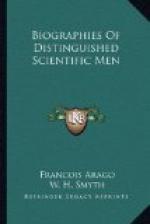The system, of which I have just given an imperfect sketch, has for its object to show how a nebula endued with a general movement of rotation must eventually transform itself into a very luminous central nucleus (a sun) and into a series of distinct spheroidal planets, situate at considerable distances from each other, revolving all around the central sun in the direction of the original movement of the nebula; how these planets ought also to have movements of rotation operating in similar directions; how, finally, the satellites, when any of such are formed, cannot fail to revolve upon their axes and around their respective primaries, in the direction of rotation of the planets and of their movement of revolution around the sun.
We have just found, conformably to the principles of mechanics, the forces with which the particles of the nebula were originally endued, in the movements of rotation and revolution of the compact and distinct masses which these particles have brought into existence by their condensation. But we have thereby achieved only a single step. The primitive movement of rotation of the nebula is not connected with the simple attraction of the particles. This movement seems to imply the action of a primordial impulsive force.
Laplace is far from adopting, in this respect, the almost universal opinion of philosophers and mathematicians. He does not suppose that the mutual attractions of originally immovable bodies must ultimately reduce all the bodies to a state of rest around their common centre of gravity. He maintains, on the contrary, that three bodies, in a state of rest, two of which have a much greater mass than the third, would concentrate into a single mass only in certain exceptional cases. In general, the two most considerable bodies would unite together, while the third would revolve around their common centre of gravity. Attraction would thus become the cause of a sort of movement which would seem to be explicable solely by an impulsive force.
It might be supposed, indeed, that in explaining this part of his system Laplace had before his eyes the words which Rousseau has placed in the mouth of the vicar of Savoy, and that he wished to refute them: “Newton has discovered the law of attraction,” says the author of Emile, “but attraction alone would soon reduce the universe to an immovable mass: with this law we must combine a projectile force in order to make the celestial bodies describe curve lines. Let Descartes reveal to us the physical law which causes his vortices to revolve; and let Newton show us the hand which launched the planets along the tangents of their orbits.”
According to the cosmogonic ideas of Laplace, comets did not originally form part of the solar system; they are not formed at the expense of the matter of the immense solar nebula; we must consider them as small wandering nebulae which the attractive force of the sun has caused to deviate from their original route. Such of those comets as penetrated into the great nebula at the epoch of condensation and of the formation of planets fell into the sun, describing spiral curves, and must by their action have caused the planetary orbits to deviate more or less from the plane of the solar equator, with which they would otherwise have exactly coincided.




